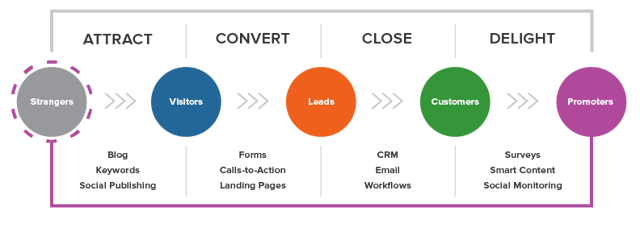
16 Reasons Leads Leave Your Site and Convert on Your Competitor's
You're following the Inbound Methodology. Your marketing team is producing great content, employing social media, and the website metrics are off the chart. There's just one little problem. When it comes time for a buying decision, leads are choosing another solution.
OK, that's not a small problem. It's a really big one. A Middle of the Pipeline Choke.
In this scenario, your content team is doing everything right at the top of the funnel. They've managed to attract prospects to your website that have identified their pain point and are considering your product or service as a solution. So what's wrong? Why aren't they converting?
The Number One Reason You Are Losing Sales to Competitors
Of course, there is an alternative. If you aren't seeing the prospects piling up and traffic increasing at a steady rate, the reason your customers are choosing a competitor is a Top of the Funnel problem. More specifically, you are losing them in the "Attract" phase of the Buyer Journey.
 Photo via: https://www.hubspot.com/inbound-marketing
Photo via: https://www.hubspot.com/inbound-marketing
If you are not seeing consistent growth in website traffic, the biggest reason you are losing sales is that they found a competitor first.
Someone else started your next customer, your top priority customer persona, down the buyer's journey.
This customer had a problem and found an alternative provider offering a solution. Your solution might be better, but for reasons we will discuss below, that was not clear to this prospect or to the search engines that ranked your site lower on critical keyword searches.
If this sounds like a possibility, read these two blogs to learn how to increase traffic and leads:
1: How To Build An SEO Foundation For Web Traffic
2: The Ultimate Guide for Using Social Media for Inbound Marketing
Now, for leads that have visited your site, and possibly even reached out for more information or downloaded a piece of content, what went wrong?
Let's pinpoint the possible problems happening in the Middle of the Funnel (AKA, where conversion occurs) and provide some strategies for correcting them.
The Other 15 Reasons your Customers are Choosing the Competitor
You Didn't Connect
Are you talking about your customers and their pains and goals, or are you only talking about your solution?
Before they look at your solution you must align with them on the problems you can solve for them. Messaging on your site should create an emotional connection with the customer personas you've identified.
Do a deep dive into your customer personas. How do they talk, what is their tone of voice and writing style? Visit websites and forums where you know your target persona hangs out - see how they talk and what they talk about. Create offers that speak directly to their needs and that are irresistible to them.
You're Talking at Them
It can't be all about you. If your website is just telling people what to do and includes a list of reasons they need your product, you've set yourself up for failure. Stretch out the buyer's journey; keep in mind, they've just met your brand.
Talk about the results of your customers, through case studies or Before/Afters. Provide the answer to how they can spend less time on their pain point (because you solve it) and more time on their personal and professional goals.
Flip the Equation
Arrange content in a way that you're not leading with your solution, you’re leading to your solution.
Along the way, include a really simple, low commitment Call to Action. We are talking about early stage prospects here, they are not ready to make a purchase or get quote, but may be really interested in a web series or e-book that provides a story about someone in a similar situation.
Here's a simple example of a tango school for adults. If you land on the website after searching for "Top Things to do in Argentina," which would you be more likely to click on?
The Hard Sell: Sign up today for Tango Lessons!
The Nurturing Offer: Download "8 Ways To Make a Trip to Argentina Unforgettable!"
Make one of the eight ideas to, "Learn to tango at an authentic Argentinian tango school" and you've led your prospect one step closer to your solution.
Provide Hope for The Future
This prospect has landed on your site because they have a legitimate problem. Let's say your business is a growing HVAC company that is trying to sell more units. You may consider listing the various choices and their stats. But let's be honest, the prospect is on your site because they are HOT and A/C is expensive.
Sell them on the future.
"Are you tired of tossing and turning all night because your house is so hot? Imagine a cool bedroom all summer long, at just a fraction of the cost you might expect. Download our guide, '8 Home Hacks to cool your home AND save money at the same time!' and cool down!"
The Second Half of that Story
Now that they know the future is good, the next half of the story should sell them on your specific service, and map out a tangible timeline. Sell the future state of where your potential customer will be after they have started working with you:
"We know you are struggling with cooling your home on a budget, and you're not alone. To help our customers on a tight budget, we have become certified installers of mini-units, which cool specific rooms of your house. Once you sign up for service, we install the units with no construction, within just one day.
Go from hot and bothered to cool and calm, within just one business day!"
Stretch the Funnel
Don't go for "the close" when it's really time for "the coffee."
 The buyer's journey isn't always direct and it takes time to build up a relationship. Customers may just not be ready to talk sales yet. Jumping from the awareness stage to a demo is way too aggressive.
The buyer's journey isn't always direct and it takes time to build up a relationship. Customers may just not be ready to talk sales yet. Jumping from the awareness stage to a demo is way too aggressive.
If you are pushing demos to leads who aren't in the consideration or decision phase, you are missing out on 70% of all traffic hitting your site. By offering them a demo too soon, and skipping the nurturing element of an exploratory action they can do on their own, and without paying you (ie. downloading an ebook, watching a webinar), you will scare your potential customers away.
Offer a low commitment offer, like a checklist, "how to," or free onsite calculator. Engage your leads now and you can nurture them to a demo when they are clearly in the consideration phase.
No Pricing, No Sale
You need to include pricing!
You want your leads to consider if the product is a good fit financially. If they can’t find the price, they can't consider the solution. When a customer is considering two vendors and can't find the price on your site, guess where they go? The competitor.
Make pricing accessible, before customers request a demo, and watch conversions increase. Most customers are not going to sign up for bottom of the funnel offers without an idea of how much your product costs.
Trust, Trust, Trust
If customers are opting for your competitor, you've lost them somewhere along the path.
A potential cause is lack of trust. You’re not going deep enough in value to prove that you understand their problem, or showing how you’re going to bring value.
Demonstrating a commitment to solving the same problem for others can turn things around. Leads want to see a pattern of success from an expert.
One great tool for establishing trust is through social media. Take for example Kayla Itsines, an incredibly successful weight loss and health guru. Sure, she is selling a weight loss program. But every day, she is sharing success stories on Instagram & Twitter from real people that have had success on her programs. By growing a community of dedicated followers, the trust is implicit; her program works and she wants to help you do the same exact thing.
Weak Branding
The old adage, "Dress for the job you want," applies for websites too. If your site looks bad and it doesn’t look like you’ve invested in yourself, why would anyone choose to invest in you? Fix bad links, outdated information, update old versions, and make your website look as successful as feel.
Keep your customer personas in mind, as well as your positioning. Premium products need a premium website. If you're a value provider, simply consider the style and aesthetics your customers appreciate.
Here's a hint. No one likes a broken down website with buttons that don't click through or typos. Do an audit of your site, or use a free website analyzer, to find areas that require updates.
Be Specific & Concise
Recent statistics measure how long a website can hold a user's attention. It's something like 10 seconds.
If you can't capture and keep someone's attention on your website in a matter of seconds, do some aggressive editing.
Hint: Readers LOVE numbers and statistics. Replace words like, "many, most, some, a few" with digits and "Top 10 Lists." Make them detailed and specific. If you’re offering a checklist what is it? Is it a list of 87 ideas or 5 in-depth guides with step by step instructions?
Be specific in your Calls to Action and requests. What does “try” something look like? Will the lead be able to use it for a month or is it an unlimited offer?
Talk the Talk
Employ their words, not yours. Here's an example. In the horticulture industry, trees are measured by the diameter of their trunk, not the height of the tree. If landscaper's website is trying to sell a 3" shade tree, that description is not only meaningless but totally confusing to the prospect.
Use words and terminology that your ideal buyer understands. Examples like the landscaper above provide a great opportunity to coach the lead and position yourself as an expert. A blog post like, "4 Reasons Quality Landscapers Measure Trees by the Inch" not only provides answers, but positions the landscaper as a quality provider of plant material.
Take a Stand
Go ahead and announce your intentions. Take the example of the tango school website from above. While they may know other styles of dance, tango is their specialty. Calling themselves a dance studio is confusing and a waste of your time and your customers'.
Focusing on one area of expertise, and communicating a unique value proposition, will keep REAL tango enthusiasts on your site, instead of hitting the back bar and continuing to search for a classic tango school.
The Buyer's Journey is Confusing
The lead has completed the workflow and didn't convert. We would recommend trying again from another angle, but before you do, reconsider the buyers journey. Have you connected all the dots? Is something missing along the way that would have pushed them to you instead of the other vendor?
If you're tracking the metrics, send highly engaged leads new content based on smart functionality -especially if you've managed to learn some valuable data about them along the way.
Another option is to compare your buyer journey to your competitions'. Did the other service providers offer a webinar or a killer free trial? See if you can pinpoint why and where you are losing prospects and re-focus the workflows accordingly.
The Journey Stalled
Is it possible you didn't follow up? You attracted them to the site with great content, earned their trust and convinced them your solution was viable. What came next?
Test bottom of the funnel offers and send them an incredible opportunity to try your product. Don't forget to ask for their business.
It's Time to Bite Back
Middle of the Funnel is critically important to keeping leads and prospects engaged and focused on your product and service versus the competition. Use these guidelines to review and refresh your content and workflows and watch those sales metrics reverse. Competitors, be warned.
Julie is a content creator and Inbound certified marketer for Lean Labs. She has a BBA and MBA with a marketing specialization and has been concentrating on Inbound Marketing for the last 4 years. Julie lives in the midwest but loves the mountains and typically travels with her husband, two kids and the best dog ever, Lucy.
About Lean Labs
The only outsourced growth team with a track record of 10X growth for SaaS & Tech co's. 🚀
Explore Topics
Recent
Related
Popular
- Ask These 6 Questions Before Hiring a HubSpot Onboarding Agency (+ How To Find a HubSpot Partner)
- HubSpot Marketing Hub Onboarding: A Step-by-Step Guide for Startups
- What Makes Great B2B SaaS Website Design? 5 Examples to Copy
- SEO for B2B SaaS Startups: Best Practices and Worst Pitfalls
- B2B Marketing for Tech Companies: Tips, Tools, and Tactics
- Using a Soap Opera Email Sequence to Convert Leads
- Customer Acquisition vs. Lead Generation: Which One Builds Growth Faster?
- Lead Generation Pricing: How Top Lead Generation Companies Price Services
- Organic Leads vs. Paid Leads: Which is Best for Growth?
- 5 Tips to Build a High-Traffic Website in 2024

Discover the Hidden Strategies We Use to 10X Our Clients Growth in 36 Months!
The Growth Playbook is a FREE guide to planning, budgeting and accelerating your company’s growth.



